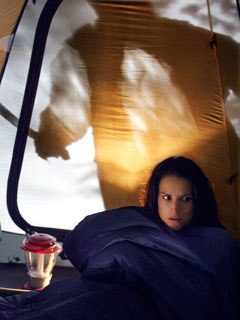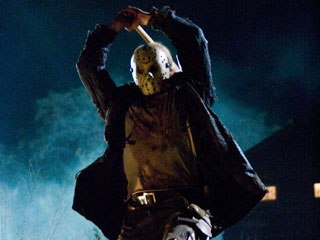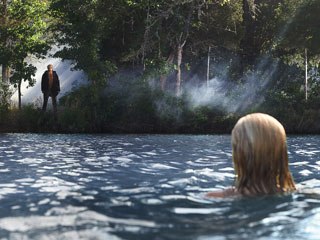Got paraskavedekatriaphobia? We'd avoid the new Friday the 13th in that case.
There's no escaping the iconic elements of '80s nostalgia forever tied to Friday the 13th and its many sequels. From Jason Voorhees and his hockey mask to the tingle of fear that shoots through an audience when Harry Manfredini's score whispers, "ki ki ki, ma ma ma," the series remains one of the most popular horror franchises of all time. Now, with Platinum Dunes re-imagining the original film for an audience almost 30 years later, how does Jason come to life in a digital world? The answer lies with Asylum Visual Effects, whose work on the project pushes the notion that, when it comes to VFX, less can be a whole lot more.
From the earliest stages of the films' conception, director Marcus Nispel issued the edict that all effects needed to be, whenever possible, done practically, aiming for what he refers to as a "snuff charm" in the style of the original Texas Chainsaw Massacre director Tobe Hooper. This meant a lot of on-set prosthetics and quite a bit of blood and gore on the part of the makeup department.
"I have two kids," says producer Brad Fuller in full agreement. "And they know when there's CGI on the screen... In a slasher movie, what we have to do to really scare the audience has to feel very real."
A major part of Asylum's contribution in the pre-production stage was to evaluate the script and pinpoint precise scenes in which vfx could be used to enhance or augment the scares. Asylum's Mitchell S. Drain had a crew of about 10 working on Friday and, in the end, the house only ended up working on about 25 shots total. Still, despite being few in number, their subtlety added a lot to the scare level.

"It's no secret that these are lower-budgeted films," says Drain of the genre. "And we all have champagne tastes. It's our job to bring the champagne in out of the budget... [Marcus has] an awesome eye and a pretty good understanding of what we do on the [vfx] end. He's of the school -- kind of like I am, even though I'm a vfx guy -- that there's the real deal and if you can get it for real, it's always better."
The first major challenge for Asylum's team was one the film's first kills. Jason has dragged a girl from her tent inside her sleeping bag and suspended her from rope over a blazing campfire, cooking her inside the bag. Not only would an effect like this be dangerous to attempt live for the actress, the on-location set in the woods of Texas made setting up a practical fire very prohibitive. Rather than create CG fire, fire elements were shot elsewhere and composited into the shots.
"As early as five years ago," explains Drain, "Realistic-looking fire in a computer generated sense was almost impossible. It was just kind of starting to come around. Nowadays, you can do some very realistic computer-generated fire. But one of the big problems is that computer-generated fire, within the context of real fire, is very difficult to pull off. For all the technical proficiencies that we have, the real thing has a look that's still very hard to do."
Asylum Compositor John Stewart led the charge, shooting and then blending alternative footage of a campfire into the shots. While the effect in and of itself wasn't terribly difficult to accomplish, the real challenge lay in maintaining continuity between the cuts, augmenting the flames as necessary to match from frame to frame.
One of the more classic Jason kills has one character getting run through with the character's signature machete. Unlike the 1980 film, Nispel wanted to be able to have the kill occur inside a single shot, so Asylum went to work, extending the practical effects and masking the artificial blade with CG trickery.
"Obviously, in the old days you couldn't really show that too realistically," adds Drain. "You'd switch between a lot of cutaways and things like that. In this particular case, we still did a cutaway from the back and when we came around the front, you see the machete is in the head. But what you also see is that the head itself has split a little bit. The head is parted and you can actually see into the skull. Some blood is trickling down the face... We can show the whole thing in one, unbroken cut and really keep the audience guessing."
Another bladed death involves the blade being pulled out after the kill is complete. Drain recalls the super-subtle vfx work done to the scene to make it just a bit more realistic.
"We had the actor who is supposed to be dead there and a kind of machete handle with a small piece of blade that was more or less pushed up against the head looking like it was him. But when he pulls the blade out, you don't want to show that it's a partial blade so we extended it. It's very, very quick, but it's also one of those things that you don't want to let go by."
On top of the work done to the blade, Asylum went in and actually did some adjustments to the actor's facial features to get a post-mortem look that just can't be acted. "There's the separation of the head. You couldn't do that [practically] because that's almost like a subtractive effect. You're taking something away rather than putting something on the actor. So that had to be done digitally. We also took the features of the actor and kind of drooped them a little bit and just put the eye off-center so that the overall effect should hopefully be very unsettling so that all these nerves were cut and one half of his face was still pretty present and the other half was kind of drooping and looking off in the wrong direction. It was just a very quick, kind of disturbing vision."
For other kills, Drain explains that weapons were created completely within the computer. At one point, Jason throws a hatchet that Asylum built as a 3D render and composited into the scene. "You see the hatchet actually behind the character flying towards him and actually bury itself in his back. [These are] things that you just couldn't get with practical photography."
Another kill involved replacing a practical spike on the back of a tow-truck with a CG one, just in time for it to burst through a character's chest. "Jason picks [a guy] up and just nails him on this spike. Again, that was done as a digital effect because you really can't do that in one take. So the actor was hoisted up on some wires and pushed back and then, with digital effects, we created a CG spike that burst through his shirt and finished out the effect. In conjunction with the practical effects of the blood squirts and the wires and things like that."
One elaborate sequence features a character, Chelsea (Willia Ford) swimming in Crystal Lake as her boyfriend Nolan (Ryan Hansen) pilots a speedboat. Jason, lurking in the woods by the side of the water, takes aim of Nolan and puts a hunting arrow right through his head. Because of the suddenness and detail of the shot, the arrow had to be created digitally and added in post-production. When it strikes, the boat goes out of control and winds up hitting Chelsea dead-on, nearly knocking her unconscious.
"Even with all the sophisticated stunts that we can do, you don't want to put somebody in that kind of danger," says Drain, "So that was done as a digital composite where we shot an actress in the water reacting to the boat and then we shot the boat and then we put the two together so it looks like she's getting hit."
Despite all of Asylum's touches, Drain maintains that the ultimate goal was to, for the most part, just steer clear of vfx and the let the practical scares play with the audience just like they did in the 1980 original. "[This] is a level of reality that wasn't available to the [original] filmmakers... We just want to give the audience a tiny bit more than what they've seen in the past."
Silas Lesnick is a freelance writer and critic. Now living in L.A., he graduated from Emerson College with a degree in media arts and has spent time working with the American Film Institute in Washington, D.C.











